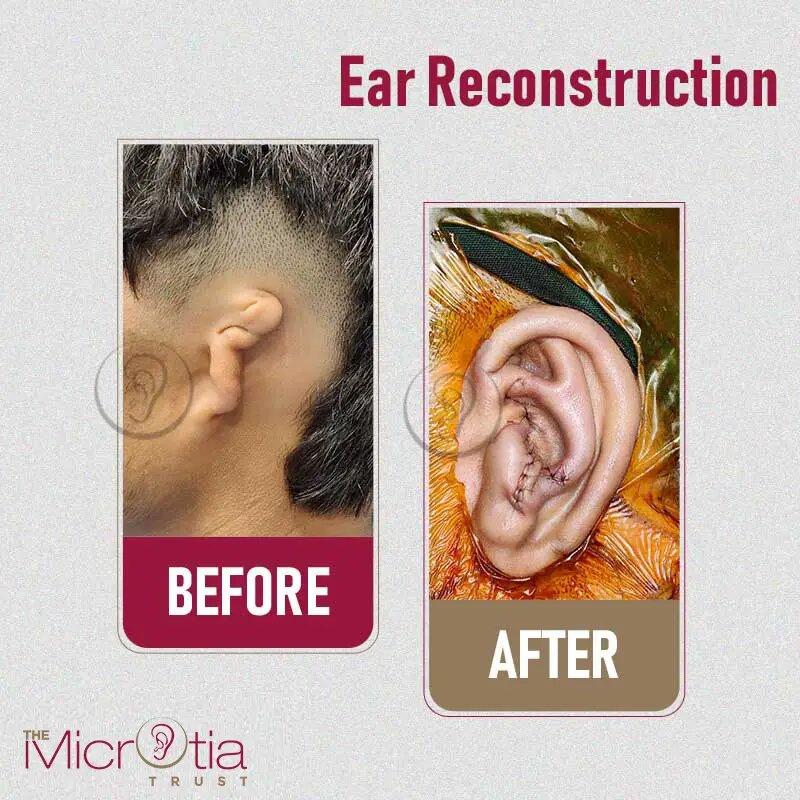Everything One Needs To Know About Ear Reconstruction Surgery

Ear reconstruction is the process of rebuilding an ear damaged by trauma, cancer, or is missing or misshapen due to a congenital condition present at birth. Ear reshaping surgery in India is usually performed during the childhood years of the patient. People who suffer from congenital defects like microtia, genetic conditions like Goldenhar syndrome, or have large, pointed, or lop ears undergo ear reconstruction surgery. This article aims to detail the different types of ear reconstruction surgery, how the procedure is performed, and how to prepare for the procedure.
Who is an Ideal Candidate For Ear Reconstruction Surgery?
The most suitable candidates for ear reconstruction surgery are individuals above the age of five who have good general health and are non-smokers.
What are the Types of Ear Reconstruction Surgeries?
The different types of ear reconstruction surgery are as follows:
Microtia Repair
Microtia, also known as tiny ear, is an inherited disorder in which one or both external ears are small, missing, or deformed.
This could be a congenital condition or the result of a genetic defect.
To repair microtia, the ear surgeon will create a new ear out of the patient’s body tissue. This can involve rib cartilage, or they can create an artificial ear (prosthetic).
Otoplasty
Otoplasty is a cosmetic procedure that targets the visible and outer parts of the ear.
Ear pinning is a surgical procedure performed to angle the ear close to the head and to make it appear less prominent.
Ear Birth Defect
Trauma or conditions like cancer surgery can cause tissue loss, necessitating plastic surgery to restore the outer ear's functionality. If one is looking for a top ear surgeon, one can consult Dr. Parag Telang at the Microtia Trust.
What Happens During Ear Reconstruction Surgery?
To perform ear reconstruction surgery, either local anesthesia with sedation (which numbs the area of the procedure) or general anesthesia (which puts the patient to sleep during the procedure) is used.
An incision is made on the back of the ear or inside the folds of the ear.
Depending on procedure type, the tissue of the ear is then manipulated. This may include removing cartilage or skin, folding and shaping cartilage using permanent sutures (stitches), or grafting cartilage to the ear.
The ear surgeon uses sutures to close the incisions.
Some surgeries don't require making an incision; instead, a needle is put into the cartilage to make it more flexible, and stitches are then used to fix or reshape the ear.
Depending on the severity of the condition and the type of procedure, the entire process can take one to three hours.
How to Prepare For Ear Reconstruction Surgery?
The patient should tell the doctor about any herbs, vitamins, or medicines they are taking.
Let the doctor know if one has any injuries or illnesses.
Do let the doctor know if one is allergic to any medicines, chemicals, iodine, tape, or anesthesia.
The patient should quit smoking at least fifteen days before the procedure.
A few days before the procedure, the patient might receive instructions to stop taking blood thinners like aspirin and warfarin.
If the patient is going to be put to sleep, they will not be able to eat or drink anything after midnight the day before surgery.
How is Recovery After Ear Reconstruction Surgery?
Bandages will be put around the patient's ears to support and protect them after the treatment.
It is normal to have some redness, itching, swelling, and pain after the treatment.
The doctor will give the patient painkillers to ease their pain and discomfort.
To avoid putting pressure on the ear, the patient shouldn't sleep on their side until they have fully healed.
The person who underwent the surgery shouldn't rub or put excess force on the incisions.
To prevent clothes from rubbing against the ears, the person should wear button-down shirts or shirts with collars that don't fit too tightly.
A few days after the surgery, the doctor will take off the bandages. The ears might get red and swollen.
The patient might have to wear a loose headband that will cover the ears at night for a few weeks. This will prevent pulling the patient’s ear forward when rolling in bed.
The surgeon will remove the non-dissolvable stitches a week after the procedure, while the dissolvable stitches will dissolve on their own.
It is vital for one to follow the surgeon’s instructions properly. The surgeon will instruct on when the patient can resume bathing or any other activity.
Light exercise such as walking can be resumed a few days post-surgery.
The patient should avoid strenuous physical activities and heavy lifting for at least 15-20 days post-surgery.
It is also advised to avoid swimming for 4-6 weeks post-procedure.
Avoid using tanning beds or exposure to the sun for at least six weeks after surgery.
Consult the Top Ear Surgeon at Microtia Trust
If one is searching for a renowned Top ear surgeon in India, one can consider consulting Dr. Parag Telang. He specializes in performing several ear reconstruction surgeries like anotia, microtia, otoplasty, prominent ear correction and many more.
For more details on these ear surgeries, visit Microtia Trust.

Comments